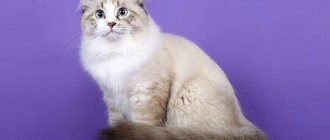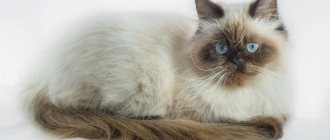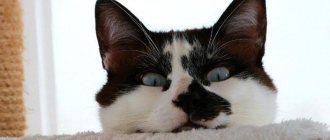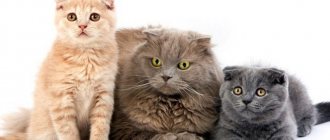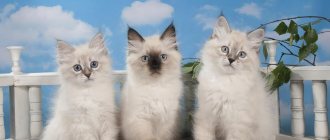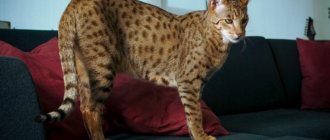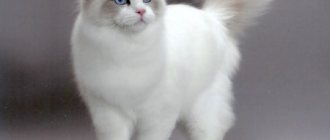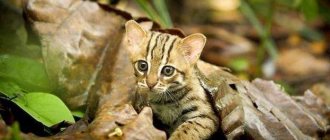Today, dear readers, we will reveal all the secrets of our domestic, unusually beautiful cat breed, with sky-blue eyes and a mysterious mask on its face - this is the Neva Masquerade cat . Why did this cat breed receive such a poetic name and is it connected with St. Petersburg? What colors can the Neva Masquerade cat boast of? Is it true that these cats are hypoallergenic? — find out all this and much more from this article.
History of the origin of the Neva Masquerade cat breed
Today's story will be about our native, unusually beautiful breed of cats, called the Neva Masquerade. Based on the name, you will probably immediately think that this breed is the result of the fruitful work of St. Petersburg breeders. Actually this is not true. It originates from the Siberian cat breed, as one of the branches of Siberian breeding, which was later separated into a separate breed because of its specific color-point color, which is popularly called “Siamese”.
A short excursion into the history of the breed. Unfortunately, we do not have exact information about where the first representatives of this breed came from, but we have several assumptions. According to them, “newaki” (an abbreviated, slang name for this breed among felinologists) appeared as hybrids of a Siberian and Siamese cat, or a Siberian and Himalayan cat , which are characterized by exactly this coat color. Although it is quite possible that hereditary recessive albinism was to blame. One thing is certain - the Siberian cat is their closest relative.
In 1988, a cat exhibition took place in St. Petersburg. It featured both purebred cats and ordinary cats. The owners brought them to the exhibition in the hope that the experts would help them determine the breed of their pet. Several cats were also presented at this exhibition, very similar to Siberian cats, with a strong muscular body and long hair, but with blue eyes and an unusually bright color with a mask on the face. This immediately brought to mind the era of Peter I, balls and masquerades on the banks of the Neva. Under the influence of all this, it was decided to give a beautiful poetic name for the new breed - Neva Masquerade.
Unlike the Siberian cat, not all felinological associations distinguish the Neva Masquerade as a separate breed, but consider it only a variety of Siberians with its own specific color. Even the breeders themselves were divided into two camps: “For making it a separate breed” and “Against”. However, these are all just legal subtleties. And let everyone decide for themselves whether to consider the Neva Masquerade as an independent breed or not, but they certainly won’t get any worse from it.
In Russia, the popularity of these blue-eyed beauties is rapidly growing, and in Europe and America they have long been at the peak of popularity and are not going to lose their positions. They are highly respected and appreciated abroad, which is good news.
Interesting facts about Nevaks
The beauty, proud disposition, but at the same time responsive character of the Neva Masquerade cats won not only the hearts of Russians, but also residents of Europe and the USA. Many celebrities become owners of Siberian Color Points. Thus, the companion of the Russian ballerina Anastasia Volochkova is a kitten Georges of the Neva Masquerade breed. TV presenter Tatyana Pushkina has a cat called Stesha.
One of the most famous representatives of the breed is the cat Dorofey, who lives with the Prime Minister of the Russian Federation Dmitry Medvedev. In the Internet community and Russian media, Dorofei received the proud title of “the country’s first cat.” He became famous for his fighting character and the attempt on the life of Mikhail Gorbachev’s cat, who lived next door. Thanks to Dmitry Medvedev, Tarja Halonen, the former head of Finland, got Nevaki kittens. Russian President Vladimir Putin presented a Siberian Colorpoint to the governor of the Japanese prefecture.
Hollywood appreciated the beauty of Siberian colorpoints. The cat Blue-Eyed Angel became the star of the film “Nine Lives”. According to the plot, workaholic millionaire Tom Brand, played by Kevin Spacey, moves into his body (into the body of a cat named Fluffy Pants) after an accident.
Are you the owner of a Neva Masquerade cat? Leave your feedback about your pet, it will be useful to all future and current owners of this wonderful breed.
Appearance of the Neva masquerade cat
The Neva Masquerade has the same breed standard as its related Siberian cat breed.
Accordingly, the animal is quite large with a strong, muscular body. The neck is strong and short. The limbs are powerful, with the hind legs slightly longer than the front. The paws are wide and round with tufts of hair between the toes. Wide tail of medium length, evenly pubescent. The ears are of medium length, wide at the base, tapering towards the end, the tips are rounded and may have tufts. The head is small in size, proportional to the body, shaped like a trapezoid with a smooth transition from the nose to the forehead. The cheekbones and whisker pads have smoothed features. The main decoration of the Neva Masquerade is, of course, their eyes. They are round in shape, medium in size and spaced widely apart. Eye color can be any rich, blue shade.
Nevak kittens, like Siberian kittens, grow for quite a long time and are finally formed only by 3-5 years, reaching medium or large sizes. Cats are significantly larger in size than cats. An adult has a considerable weight: 3-4 kg for females and 6-10 kg for males.
The Neva masquerade coat is water-repellent and has a hard-to-touch outer coat. On the sides the coat is softer, denser, but loosely fitting. The undercoat is double, which changes depending on the season. In summer it is short and not significant, but in winter it grows luxurious, long and thick. On the neck there is a decoration in the form of a “collar”, like a lion’s mane, and on the hind legs there are “pants”.
Character and habits
The Siberian masquerade cat seems stern in appearance, but appearances are deceiving. Those who have already had experience keeping these animals speak of them as gentle, devoted and loving pets. They amazingly combine nobility, calmness and the ability to stand up for themselves.
They fearlessly defend their territory and hunt well, despite the fact that they sometimes seem phlegmatic. However, this does not prevent them from showing patience with children. The Siberian masquerade is not capable of offending a child. Feeling tired from the baby’s excessive attention, she will prefer to go to another room.
The pet is equally attached to all family members, willingly accepts affection, but never imposes its company. Behaves cautiously with strangers. When there are a lot of guests at home, the cat usually goes to a quieter place. The animal knows how to sense a person’s mood and often comes to the rescue when the owner is depressed. The pet rarely gives voice, unless very hungry. He can “keep up the conversation” by responding to the owner’s affectionate remarks.
Siberian masquerade cats can get along with dogs, and in rare cases, with other cats, if they do not claim dominance. Pets raised together perceive each other calmly. What the Nevak will not be able to make friends with is small rodents and birds due to its highly developed hunting instinct.
The hunting instinct does not allow nevaks to live in the same apartment with domestic rodents and birds
Colors of the Neva Masquerade cat
Let's look at the main colors that are typical for our mysterious cat “in a mask”. As mentioned above, Neva masquerade cats are characterized by a color-point color. The body of the animal is painted in lighter colors, and the tips of the ears, paws, tail and mask on the face have a darker shade; these dark areas are called points (point - tip). Points form on colder areas of the body. Depending on the color of these points, the following color varieties are distinguished:
- Seal-point - Classic color-point color, when the points have a black tint, and the body itself is painted beige or sand.
- -point - Today this is the most popular color of Nevaks. The points are grey-blue.
- Red-point (red-point) - Points of a red-red color.
- Cream point (cream-point) - The lightened color of the red point, in which the points are cream/beige in color, from a distance the cat seems almost one color.
- Tortoiseshell Point/Torty-Point - Available in both black and red, or in various lighter shades. Characteristic only for cats.
- Tabby-point - A combination of points with a patterned tabby color, characteristic of Siberians. Stripe patterns are found on the face, tips of the paws and tail. A pattern in the form of the letter “M” can be traced on the forehead. Depending on the colors of the markings, there are several types of tabby point: seal -tabby-point - black points with a pattern.
- blue -tabby-point - blue points with a pattern.
- red -tabby-point - red points with a pattern.
- cream-tabby-point (cream-tabby-point) - cream points with a pattern.
All the colors described above can also be combined “with white,” when the cat’s body is “whitened” in varying proportions. The most common option is white socks on the paws or a white chest. There are cases when half of the animal’s body is painted white - bicolor.
You can see examples of each color in the photographs below:
- Seal Point
- Blue Point
- Red point
- Cream point
- Torty point
- Tabby point
Seal Point
Blue Point
Red point
Cream point
Torty point
Tabby point
It is also worth noting one interesting feature - the kittens of the Neva masquerade cat are born completely white without any markings. Markings begin to appear only after a couple of weeks of birth. Therefore, it is impossible to immediately understand what color the kitten will be.
How to choose a kitten and how much does it cost?
It is better to buy an animal from professional breeders. In this case, the new owner will receive documents for the pet - pedigree, veterinary passport, contract. Kittens of the Siberian Masquerade breed are born completely white; points on the coat appear later. Babies are taken from the nursery at three months of age after vaccination.
When buying a kitten, you should make sure that it is healthy. An animal that feels good has a neat, shiny coat, clean eyes and ears. The pet is moderately well-fed, active and good at contact. Characteristic signs of illness are as follows:
- lethargy, depression;
- scratches and bald spots on the body;
- discharge from the eyes and nose;
- dark wax in the ears;
- dirty under the tail;
- unkempt, disheveled fur.
The cost of kittens depends on belonging to a certain class. The most expensive individuals are those that have every chance of participating in exhibitions in the future. These are show-class animals, prices for them start from 35,000 rubles. Kittens with minor defects, but suitable for breeding, cost less - 15,000–25,000. The most inexpensive animals belong to the pet class, these are cats intended only for home keeping. Their estimated cost is 10,000–15,000 rubles.
There are usually 3-4 kittens in a Neva Masquerade litter
Character of the Neva masquerade cat
Despite their aboriginal origin and impressive size, these cats have a calm and balanced character. They are excellent defenders from encroachments on their territory or their offspring, this is especially true for a mother cat. They often recognize only one owner in a house and try to always be near him, thus showing their devotion. Not only do they love to communicate with you, but they can also be an attentive and understanding listener. They treat strangers very coldly and warily. It's rare to let a stranger take you in the arms; in the beginning, you have to gain his trust.
From childhood, you must make it clear to the kitten what he can and cannot do. If you allow him to sleep on your bed, then be prepared to endure this every day, and not just when you are in a good mood. The intelligence of these cats is very high compared to their feline counterparts; they understand everything and can quickly adapt to various situations.
And of course, one cannot fail to mention the Neva Masquerade kittens, which are particularly playful. They can’t sit still for a couple of minutes, they just rush around, run and jump, but that’s what they’re kittens for. And these cats really jump very high, both in height and in length.
If several Nevaks live in your house, then they will never be on equal terms with each other, someone will definitely take leadership and rise above the rest, a certain feline hierarchy will be visible. Only the leader will sleep next to the owner, others will usually be a little further away.
If your family has a small child, then you can rest assured – these cats love children and will not offend them. At some intuitive level, cats understand that this is a baby and should be treated with more care and caution.
Adaptation of a cat in a new home
If we talk about the adaptation of the Siberian cat, then everything directly depends on the age at which the animal was acquired. Siberian cats are very smart and therefore, if the cat is old enough, then it will be enough to just show him where the toilet, feeding bowl, sleeping place and other necessary things are. This will be enough for him to get used to his new place in the near future. At the same time, you need to behave in a friendly manner, but not be too coddling - they have a tough character and therefore it is important for them to be perceived as a partner equal to themselves in status and intelligence.
You still need to create the most favorable conditions for kittens. A kitten that has just been torn away from its mother is afraid of everything and therefore you need to play with it more often and treat its pranks with understanding.
It is better to immediately begin to accustom your baby to order. You should not make allowances for the fact that he is small and allow him to eat where he sleeps. This will become a habit and it will be much more difficult to retrain the animal. In this case, the kitten needs to be provided with a sufficient number of toys.
If we talk about the initial care of the animal, then it is worth paying special attention to hair care and diet. Since Siberian cats have very long hair, it requires especially careful care. But if we talk about small kittens, their hair is not yet so long and therefore a regular comb with sparse teeth is quite suitable for them. This way you will be able to reduce discomfort.
The kitten's diet should be as balanced as possible. You need to include in your diet:
- dairy products, cottage cheese;
- fish, chicken. At this stage there should only be fillets;
- rice porrige;
- vegetables fruits.
At the same time, you need to make sure that the meat and vegetables are chopped, since it is still difficult for the baby to chew large pieces of food on his own.
And, of course, you need to show that everyone is very happy to see the kitten in the family. Everyone in the household should play with it. You should also instill in him a sense of home gatherings. If the whole family gathers around the TV in the evening, then the new family member should also take part in this.
If the situation allows, you can take the kitten with you on trips so that it does not feel lonely. Ideally, do not leave the baby alone for a long time, so an excellent solution would be if one of the household members is at home almost all the time. At least until the kitten is 6 months old.
Health and care of the Neva masquerade cat
Due to the fact that the Neva Masquerade has a luxurious long coat, these beauties should be combed with a special brush once a week, and they can also be bathed periodically. Unlike Persians, their fur practically does not tangle. Nevaks shed twice a year - seasonal molts. Therefore, it is during this period that your cat will actively shed fur. On such days, your cat should be washed and brushed twice as often as usual. In other periods this will not be observed. Nevaks endure bathing steadfastly and courageously. Of course, they may be “indignant” and “complain” to you, but they will tolerate water procedures. Because These are very smart and quick-witted cats, so they learn to use the toilet quickly, even as kittens. Furniture is not particularly damaged by claws.
One interesting fact is that Nevaks' fur is hypoallergenic, so if you suffer from cat allergies, then this breed is simply created for you.
The Neva Masquerade is a semi-long-haired cat, therefore, the quality of its coat and overall health will depend on what you feed it. Many breeders advise feeding your pet with high-quality professional food. You should not skimp on your cat's health. Periodically, she should be given special cat vitamins.
The Neva Masquerade cat is a native cat breed. Thus, like her Siberian brothers, she has excellent health from birth and is not predisposed to any diseases characteristic of her. Therefore, the health of your pet will depend only on you and how you look after and care for it. Well, in return, the Nevaks will reward you with boundless devotion and love. With proper care, the average life expectancy of a Neva masquerade cat is 18-20 years.
Care
Wool
Siberian Colorpoints shed twice a year. Caring for a cat is quite simple; the fur does not cause much trouble in combing, because thanks to its structure, it does not roll or mat.
If you comb your pet, with the exception of the tail, twice a week and wash it occasionally, then such problems as tedious cleaning of the house from tumbleweeds made of wool will not arise. However, be prepared for the fact that large quantities of your pet's fur will remain on your things and clothes.
Advice! To prevent the coat from darkening, Siberian Colorpoints should be kept warm.
Nutrition
Nevaks have excellent health and do not require special care. However, if you do not take into account their food needs, you can seriously harm the well-being and appearance of your pets.
When choosing food, you should pay attention to the presence of necessary microelements, vitamins and minerals. It is better to give preference to special premium food (dry or wet). You can see our rating of dry food for neutered pets here. This way, the risk of urolithiasis and other diseases will be minimized.
Natural feeding has a number of features and limitations. Table food is completely unsuitable food for cats. The diet of the Siberian Color Point should consist of dietary meat (pork should be excluded), boiled or scalded offal. Nevaks also need to be fed vegetables and cereals. Salt, sugar, smoked, fatty, fried, fish and seafood are contraindicated.
Kittens need five meals a day; we talked about how to choose food for a kitten in this article. Adult cats only need to be fed twice. Siberian Color Points are not prone to obesity, but they should be fed in portions not exceeding 150 grams.
Walking your pet
Representatives of the Siberian Color Point breed enjoy walking in the fresh air. By nature they are good hunters, strong and hardy, with excellent reactions. The courtyard of a private house can be an excellent place for walking. When living in an apartment, a balcony is also suitable.
Do not forget that Neva masquerade cats are extremely wary of strangers. If walking down the street together causes your pet stress and a lot of negative emotions, then it is better to avoid such a walk.
Neva masquerade cat price
The Neva Masquerade is an unusually beautiful and noble breed that would be a match for royalty. It’s not for nothing that D. A. Medvedev’s cat, named Dorofey, is of this breed. But fortunately for us, its cost is not at all high, and for any of us it will be affordable. You can see the average prices for Neva Masquerade cats in different countries below:
- Average price in Russia: 10,000 - 20,000 rubles.
- Average price in Ukraine: 1500 - 5000 UAH.
- Average price in the world: 600 — 1200$
Breeding
Crossing Siberian Color Points with other breeds is not allowed. Despite the growing popularity of Nevaks among breeders, it is better to look for a partner for your pet in special nurseries.
Maturity in the Neva Masquerade begins earlier than in other breeds, around the ninth to tenth month of life. The indigenous breed had to survive in harsh climatic conditions, mortality occurred early, and therefore maturation was faster. Nevaks inherited this feature genetically.
However, breeders do not recommend mating before one and a half years, in order to avoid high litter mortality.
Important! The first mating is best done with an experienced partner.
Pregnancy lasts about 9 weeks. In the future, you won’t have to worry about offspring. Cats of this breed are caring mothers.
Many nurseries are engaged in breeding Neva Masquerade cats.
In Moscow:
- Pearl of the Neva;
- Atlas grand;
- Russian Diamond;
- SiNEVA;
- Talisman udachi.
Troitsk: Vizantiysky gift.
In St. Petersburg:
- Chary Nevu*RU;
- From the banks of the Neva;
- Siberian miracle.
Photo gallery of the Neva Masquerade cat
History of origin
First, let's talk about the Siberian cat itself - what it is, where it came from, and what typical features are characteristic of it.
The Siberian cat is believed to originate from Russia. The first mention of it can be found in manuscripts of the sixteenth century. In those days, this variety was called Bukhara, and its distribution area was in the countries of Central Asia.
The cat was probably brought to Siberia by nomads and traders, who bred these animals to protect their goods from small rodents. In those days, this was relevant not only because mice and rats spoiled seasonings and cereals, but also because they carried the plague and other dangerous diseases. Therefore, the cat was simply necessary.
In the territory of Siberia and Transbaikalia, the characteristic features of this breed arose and were formed - wide bones, dense physique and thick fur with a dense double undercoat, which protected the cats from the cold.
Siberians are famous for their wide palette of colors. Among them you can find black, brindle, red, marbled, tabby, dame, tabby, and tortoiseshell cats. And even a chinchilla!
These murkas have a rich hunting past. The genetic memory of him leaves an imprint on their character and character traits. However, do not be afraid - these cats are non-aggressive. But they are inquisitive, attentive, love to play, climb into secluded places and watch their toy “prey” from above.
Video description of the Neva Masquerade cat
Video 1
Video 2
This is all I wanted to tell you about these charming blue-eyed creatures of “domestic production”. The next review will be about an unusual breed with curly wool, like a sheep’s, that appeared in the British Isles - this is the Cornish Rex . Don’t miss this new interesting review, and for this I recommend that you subscribe to new blog articles!
Dear readers, if you have any questions about the breed or just want to express your opinion, please write it in the comments.
Best regards, Denis Jafarov
Pros and cons of the breed
The Siberian Masquerade cat is highly valued for its many advantages:
- beautiful appearance;
- balanced character;
- devotion;
- tolerance towards children;
- undemanding to the food supply;
- strong immunity.
The disadvantages of the breed include:
- complex grooming;
- the cat’s reluctance to share its territory with other animals.
This breed has many more advantages than disadvantages. The same is confirmed by reviews from owners. The Siberian masquerade cat is an ideal companion with a noble disposition and magnificent appearance, not demanding in terms of living conditions.
Blue point and blue tabby point
Cats of this color have lighter points than those of the seal point color and have a gray-blue tint. It is more desirable for Blue Points than for Seal Points to have a light body, since with strong pigmentation, contrast is practically lost. More stringent requirements are also imposed on eye color: an insufficiently saturated blue color seems even paler against the background of a blue color. In recent years, many beautiful cats of this color have appeared, and they are worthy competition for seal points. Red point and red tabby point
This is still a very rare color. Therefore, if you come across such a kitten, consider yourself very lucky. Their points are red. The body is almost always almost white or with a slight golden tinge. The eyes appear even bluer against the background of the red muzzle. It can be difficult to distinguish Red Points from Red Tabby Points when kittens are activated (1.5-2 months), and even as an adult, Red Points sometimes undergo color corrections in their pedigree more than once and are finally convinced of their stripes or the absence of such only after the appearance of the first offspring. There is also a variation of cream point - a lightened red color.
Allergy
Siberian cats are believed to be hypoallergenic. Alas, there is not yet sufficient scientific evidence for this, although research is underway. But if you believe the observations of the last ten years, people prone to allergies really do not react to the fur and saliva of Siberians.
The fact is that the saliva and secretions of these cats have a minimal content of Fel D1 protein. This is what allergy sufferers are so susceptible to. Very often, even fur does not cause such a reaction - it’s just that when the animal washes itself, the protein remains on its body along with particles of saliva. For some cat lovers, this becomes a real tragedy. It’s lucky that Siberians exist!
However, it should be remembered that Fel D1 is still not completely absent in the body of these tetrapods. And to make sure that communication with them will be safe for you, you need to conduct a small experiment.
If you want to test your reaction to contact with Nevaks and Siberians, negotiate with the breeder, visit the shelter and play with these animals, hold them in your hands. If there are no skin reactions or breathing problems, then this is your cat, and you can safely invite her to live permanently in your home!

